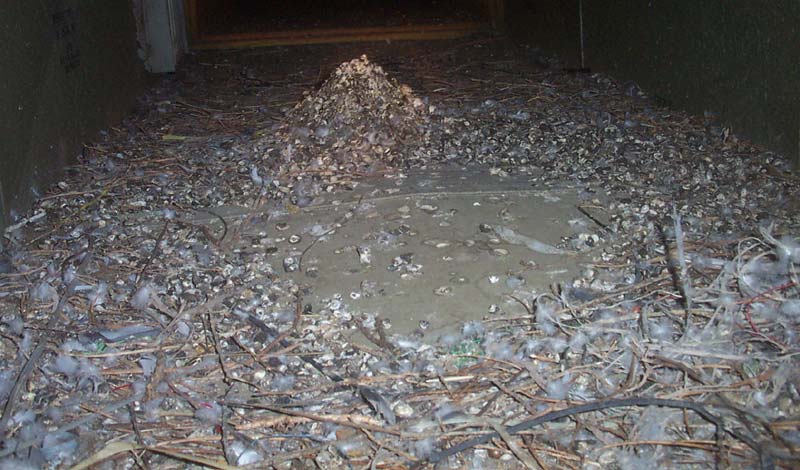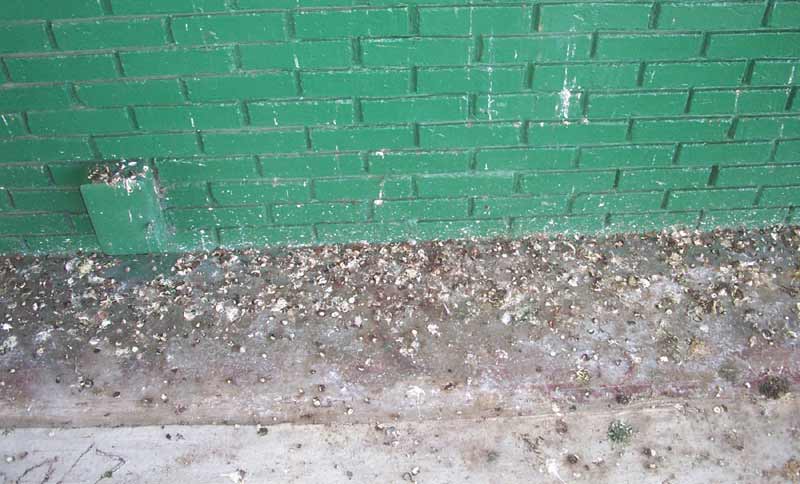-
info@aaanimalcontrol.com
Call us for help in your town
Humane Wildlife Education
Removal of Bird Droppings from Pigeons
Need bird removal in your hometown? We service over 500 USA locations! Click here to hire us in your town and check prices - updated for year 2020.
Bird droppings are an unsanitary biohazard. Large populations of roosting birds may present the risk of disease to people exposed to the area. Disease organisms
can grow in accumulations of bird poop, feathers, and nesting debris under a roost. External parasites are also a problem resulting from bird infestation. The parasites
can invade buildings and bite people.
One of the diseases associated with bird waste is histoplasmosis. Most infections are mild and produce either no symptoms or a minor
illness similar to influenza. On occasion, the disease can cause high fever, blood abnormalities, pneumonia and even death.
Another disease associated with pigeon droppings is cryptococcosis, which is yet another lung infection. Pigeon droppings are a common source of the disease fungus Cryptococcus neoformans in the environment.
The fungus is typically found in accumulations of droppings around roosting and nesting sites, for example, attics & ledges of buildings. Even when old and dry, bird droppings
can be a significant source of infection. Persons with weakened immune systems, however, are more susceptible to infection. The disease is acquired by inhaling the yeast-like
cells of the organism.
Bird roosts can harbor parasites that may invade buildings. The northern fowl mite and chicken mite are two primary parasites associated with birds. Other parasites
that may cause problems inside buildings include the pigeon nest bug (related to the beg bug), soft ticks, biting lice and the pigeon fly.
People involved in environmental cleanup of bird droppings should follow precautions to minimize risk from disease organisms in the droppings. This includes procedures such
as sealing heating and cooling air ducts, wearing respirators that can filter particles as small as 0.3 microns, wearing biohazard suits or disposable protective gloves, hat,
coveralls and and shoe coverings, moistening the bird waste with a mist of water to keep spores from becoming airborne, and properly disposing of the waste material.



How do I clean pigeon feces out of my attic?
The feces of the pigeons carry bacteria and different pathogens that may bring illnesses. You can prevent the infection by preventing the direct contact with the feces of the pigeons in the process of cleaning the areas they have roosted. The kids must be out of the place along with the domestic pets where the debris are located. Anyone who will clean up the feces of the pigeon in the attic must wear appropriate clothes and gears to protect themselves when cleaning up. The one who will clean up must wear long pants, long sleeved shirt, waterproof gloves, mask with filter, waterproof shoes and an eye protection. In the process you cleaning, you will need some important materials.
- 10% sodium solution, it is composed of a part of bleach with 9 parts of water.
- For indoor use, water the area to make sure that the air borne fumes will be settle and will not scatter in the air.
- Dip the place with the bleach solution and then leave it for around ten minutes. This will help in disinfecting and in softening the feces that has been there for quite some time now. You will not have a hard time getting rid of them anymore.
- Use an old mop or a spray bottle to spread the bleach throughout the area.
- Reapply the solution if the area will start to dry up after ten minutes.
- If the feces have accumulated over time and it turned thick, it will be best to soak it once again.
- Put the debris in a double plastic bag
- Use a shovel to scrape the debris
- Seal the bags
- Put the bags in a trash bin
- Scrub the place with a hard broom using a soap and water to remove the debris and then rinse with water
- Use a power washer to help you in doing the scrubbing method
- If needed, reapply the bleach solution and then keep the place wet for more than ten minutes. Do not rinse the area for a while.
- If the place is exposed to direct sunlight, then you can omit the scrubbing process, since the UV light has a disinfecting agent that has the capacity to treat the area.
- Let the place dry on its own before anyone goes in the area.
Pigeon infestation is a hard process, especially if you are alone in the house and then you have lots of other things to do. Your busy life will add up to the drama that this infestation problem can bring. Well, you can just call the animal control removal for help. They will be the one to trap the pigeon and then they will be the one clean up and do the repair.
Pigeon Poop On Ledge: Best Methods For Cleaning - At first glance, pigeons seem completely harmless, but the truth is they can make a lot of mess. If you do not want to turn into a cleaning freak, that continuously tries to remove pigeon poop from ledges, you will need to consider some tougher methods to get rid of the nasty critters. If you try to find some advice on how to get rid of pigeons and their droppings, you may stumble upon plenty of advice on repellants that supposedly can help you in your fight against pigeons. However, you will soon find out that such advice is nothing but hot air and that pigeons are not that easy to fool as some may think.Pigeon poop on ledge can be quite a nasty sight, not to mention, something that is not so easy to clean. The best method that you can employ is to install some kind of device on the ledge to prevent the pigeons from sitting on it. Spikes, needles and shock tracks are easy solutions, especially if you do not really want to hurt the birds. When cleaning up the droppings you?ll want to wear a mask so you don?t breathe in hazardous waste and end up with a respiratory condition. A bleach solution can be used to thoroughly scrub the area and is quite affective.
AAAnimal Control is a professional nuisance wildlife control company. It is my goal to provide information so that you can solve your bird problem in an effective and responsible manner. Wildlife services include animal trapping, capture & removal, plus animal damage repairs and preventative measures. You can always browse this site for more details and info about bird removal. If you live elsewhere in the US and have found this site and need a local trapper in your area, click here for a nationwide list of 100's of professional bird removal experts.


















